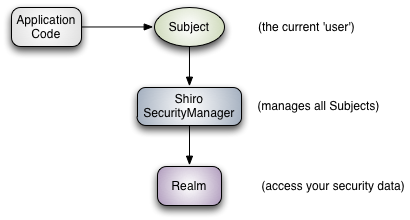本文基于shiro的web环境,用宏观(也就是不精确)的角度去理解shiro的工作流程,先看shiro官方的一张图。

和应用程序直接交互的对象是Subject,securitymanager为Subject服务。可以把Subject看成一个用户,你的所有的代码都由用户来执行。suject.execute(callable),这个callable里面就是你的代码。
一、shiro如何介入你的webapp
它是如何初始化的?servletContextListener。它是如何在每个http请求中介入的?ServletFilter.
?
1
2
3
4
5
6
7
8
9
10
11
12
13
14
15
16
17
18
<listener>
<listener-class>org.apache.shiro.web.env.EnvironmentLoaderListener</listener-class>
</listener>
<filter>
<filter-name>ShiroFilter</filter-name>
<filter-class>org.apache.shiro.web.servlet.ShiroFilter</filter-class>
</filter>
<filter-mapping>
<filter-name>ShiroFilter</filter-name>
<url-pattern>/*</url-pattern>
<dispatcher>REQUEST</dispatcher>
<dispatcher>FORWARD</dispatcher>
<dispatcher>INCLUDE</dispatcher>
<dispatcher>ERROR</dispatcher>
</filter-mapping>
EnvironmentLoaderListener会根据你在web.xml中的配置读取对应的配置文件(默认读取/WEB-INF/shiro.ini,或者classroot的对应文件),构建一个shiro环境,该环境保存在servletcontext中,所有的filter都可以获取。里面就包括一个单例的securityManager,该securityManager已经根据ini的内容进行了配置。
再看shiroFilter:
?
1
2
3
4
5
6
7
8
9
10
11
@Override
public void init() throws Exception {
WebEnvironment env = WebUtils.getRequiredWebEnvironment(getServletContext());
setSecurityManager(env.getWebSecurityManager());
FilterChainResolver resolver = env.getFilterChainResolver();
if (resolver != null) {
setFilterChainResolver(resolver);
}
}
这样filter里面就可以使用securityManager了。
下面的一段代码就是本文开头提到的Subject(用户)的创建了,因为是web环境所以每次请求都需要创建一个subject对象,在filter里面给你准备好,在你的servlet里面就可以直接使用了。
?
1
2
3
4
5
6
7
8
9
10
11
12
13
final ServletRequest request = prepareServletRequest(servletRequest, servletResponse, chain);
final ServletResponse response = prepareServletResponse(request, servletResponse, chain);
final Subject subject = createSubject(request, response);
subject.execute(new Callable() {
public Object call() throws Exception {
updateSessionLastAccessTime(request, response);
executeChain(request, response, chain);
return null;
}
});
看一下subject.execute的javadoc,写道:
Associates the specified Callable with this Subject instance and then executes it on the currently running thread. If you want to execute the Callable on a different thread, it is better to use the associateWith(Callable)} method instead.
将callable(你的所有代码都在里面执行)和当前的subject实例相关联,并且在当前的thread中执行...
二、securityManage如何为subject服务
请注意看上面最后一段java代码,里面有一个createSubject(request,response)方法,也在filter里面,它的代码如下:
?
1
2
3
protected WebSubject createSubject(ServletRequest request, ServletResponse response) {
return new WebSubject.Builder(getSecurityManager(), request, response).buildWebSubject();
}
看到没有?subject的构造用到了securityManager,所有shiro的魔法都被隐藏在securityManager里面了。接下来提一些问题,试着发现securityManager需要完成哪些工作。



